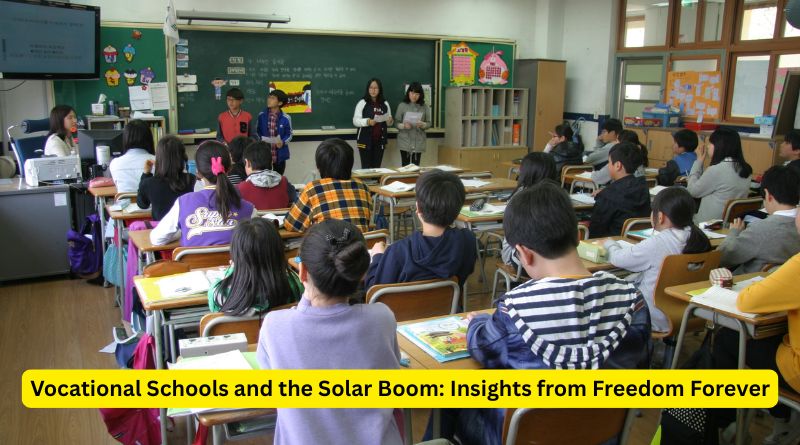The growth of solar energy in the United States is not only reshaping how the country powers homes and businesses. It is also changing how people prepare for the future of work. As utility-scale and residential solar projects multiply across regions, employers are turning to vocational schools and community colleges to help build a workforce that is trained, job-ready, and geographically diverse. Freedom Forever reviews often emphasize the company’s support for these educational partnerships, showing how investments in workforce development strengthen both career opportunities and the broader clean energy economy.
What makes vocational institutions such critical players in this clean energy transition is their ability to move quickly. With flexible curriculums, real-world training, and deep ties to local communities, these schools are producing graduates who can enter the solar workforce with the technical skills and certifications employers require. In doing so, they are accelerating the pace of solar adoption while expanding economic opportunities for a broad range of students.
Fast-Track Training for In-Demand Roles
Vocational schools offer accelerated training programs that focus on the practical skills necessary for solar installation, maintenance, and system design. Many of these programs can be completed in six to twelve months, providing a faster and more affordable alternative to four-year college degrees. Students learn how to manage electrical equipment, install photovoltaic systems, and follow industry safety standards.
This hands-on approach is ideal for solar companies that require workers who are field-ready on day one. Employers look for candidates with experience in wiring, roofing, or project planning, all of which are commonly included in vocational school training. The result is a steady supply of technicians who are already familiar with the solar industry’s tools, materials, and job site expectations.
Meeting the Needs of Local Economies
One of vocational schools’ great strengths is their connection to the regions they serve. These institutions often tailor their solar programs based on the hiring needs of local employers and state-specific regulations. In areas experiencing rapid solar growth, such as Texas, Arizona, and New Jersey, vocational programs are helping fill gaps in the labor market and reduce project bottlenecks.
These schools also serve students from a wide range of backgrounds, including adult learners, career switchers, and first-generation college attendees. For many, the ability to quickly train for a stable and well-paying job in their community is a powerful incentive. By offering accessible career pathways, vocational schools are ensuring that the benefits of the solar boom reach more people, especially in rural and historically underserved areas.
Building Strong Industry Partnerships
To stay relevant and responsive, vocational schools increasingly collaborate with industry partners to shape their programs. Companies provide input on curriculum design, participate in job fairs, and even donate equipment for training labs. These collaborations help ensure that students graduate with skills aligned to current technologies and business needs.
Companies have been active in supporting workforce development by participating in regional job pipelines, offering internships, and helping to align educational outcomes with real-world expectations. In some cases, companies even hire directly from partner institutions, making the transition from classroom to jobsite seamless for graduates.
Integrating Certifications into Training
Many vocational programs now include nationally recognized certifications as part of their curriculum. These include credentials such as the NABCEP (North American Board of Certified Energy Practitioners) PV Associate Certificate and OSHA 10 or 30 safety certifications. For students, these credentials are an asset that demonstrates readiness and competence to employers.
Integrating certifications into training means students can leave school not just with theoretical knowledge, but with the verified skills needed for immediate employment. It also benefits employers who can trust that new hires meet baseline safety and technical standards, reducing the time and cost required for onboarding and supervision.
A Reflection of Training Investment
The impact of these educational partnerships can be seen in how solar companies talk about their workforce. Freedom Forever Reviews frequently highlight the company’s commitment to internal advancement and ongoing training. Employees often mention how they began in entry-level roles and grew into supervisory or technical positions thanks to continued learning support.
This kind of internal mobility is only possible when the workforce arrives with a solid foundation. Vocational schools provide this by equipping graduates with the basic skills, confidence, and adaptability needed to grow within a company. As solar technology continues to develop, that foundation becomes more important than ever.
Supporting Workforce Diversity Through Access
Vocational institutions play a crucial role in expanding diversity within the solar workforce. They provide educational opportunities to students who may not have access to traditional four-year colleges, including veterans, single parents, and individuals transitioning from other industries. Many programs offer flexible scheduling, evening classes, and financial aid to remove common barriers to participation.
By tapping into a broader talent pool, the solar industry benefits from new perspectives and experiences. That is especially important in a sector that serves diverse communities and is increasingly focused on equitable development. Vocational schools, through their commitment to inclusion and community engagement, are helping to make solar careers accessible to all.
Government Support Strengthening the Pipeline
The importance of vocational training has not gone unnoticed by policymakers. Federal and state governments have directed funding to support clean energy education through workforce grants, public-private partnerships, and Registered Apprenticeship Programs. These initiatives help schools expand their capacity, update equipment, and reach more students.
Many vocational programs have leveraged these resources to improve their offerings. With government support, schools can integrate modern technologies like battery storage and electric vehicle charging into their curriculum, ensuring students are prepared for the next wave of solar innovation. The result is a more agile and prepared workforce, ready to meet the sector’s expanding demands.
Long-Term Impact on the Solar Economy
The benefits of vocational training go beyond individual employment. By producing a steady stream of skilled workers, these institutions help stabilize project timelines, reduce installation costs, and increase customer satisfaction. It, in turn, strengthens public confidence in solar energy and drives further adoption.
As the U.S. targets hundreds of gigawatts of additional solar capacity by 2035, vocational schools’ role can only grow more important. Their ability to adapt quickly, partner effectively, and reach underserved communities makes them one of the most valuable assets in the clean energy transition. By investing in these institutions today, the industry is laying the foundation for tomorrow’s success.





